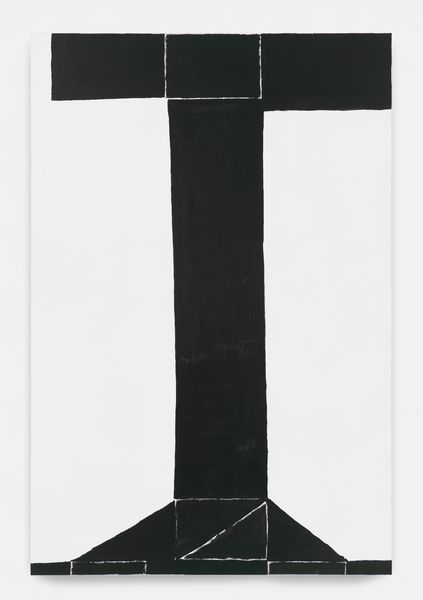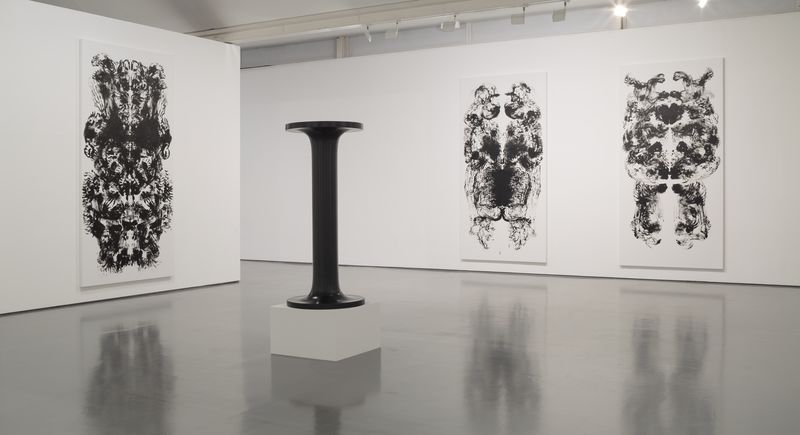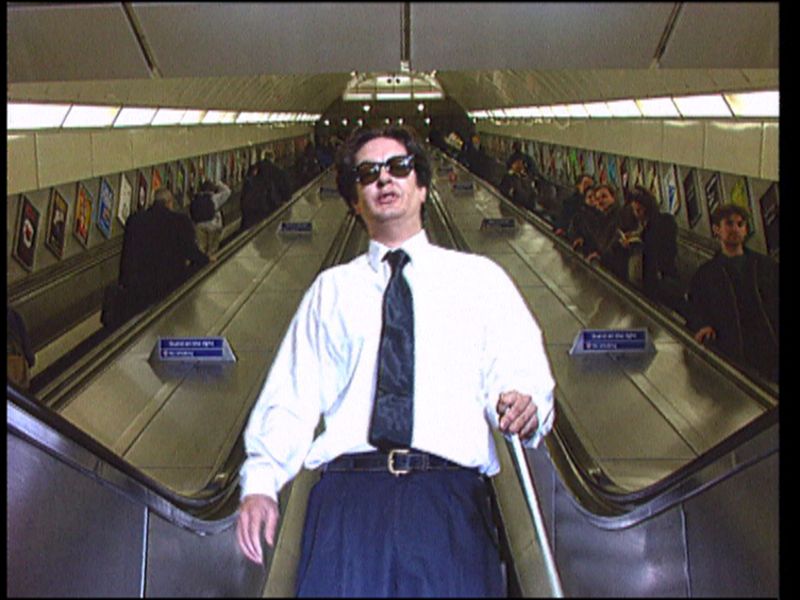Mark Wallinger: Alter Ego

Mark Wallinger, ‘Passport Control’, 1988 © Mark Wallinger. Courtesy the artist and Hauser & Wirth. Photo: Alex Delfanne
Mark Wallinger: Alter Ego
Sunday 11 March 2018
What's the strangest thing that's ever happened to you? Chances are, it's not nearly as weird as Mark Wallinger's – an incident that involved an art gallery, a photographer, and a stranger dressed as a bear.
In 2004, for his performance piece Sleeper, the artist dressed up in a bear costume and occupied Berlin's Neue Nationalgalerie for ten nights. Having lived in the city himself, Wallinger was fascinated by the relationship between Britain and Germany. "It's quite a long story of why it ended up being a bear in the Neue Nationalgalerie." he laughs. "But the bear is the symbol of that city. And it was an English bloke in it.
"It was about my experience of living in Berlin for a couple of years - and enjoying being a bit other, and alien, and getting off on the differences. I think the English and the Germans are quite yin and yang; we like and admire the qualities in each other that we don't quite have. I became interested in all that. And it's a city that wears all its scars." The long story encompasses myriad references and rationales for a work that explores Wallinger's relationship with Germany - from the Cold War spies known as 'sleeper agents' to The Singing Ringing Tree, an East German children's film which also aired as a BBC series.
Featuring a prince that gets turned into a bear, it formed a foundational part of British and East German culture for many in Wallinger's generation (though not, interestingly, in West Germany, thanks to the Berlin Wall). In what Wallinger describes as "quite a nice postscript" to the performance (and the aforementioned weirdest experience), he was finishing up late one night when his photographer asked whether he had seen the other bear.
"What other bear?" Wallinger asked. The photographer took him around to the back of the gallery, where a figure in an identical bear suit was watching the performance through the glass. The other bear gambolled off as they tried to approach it; its identity has remained a mystery.

Mark Wallinger, ’Sleeper’, 2004 © Mark Wallinger. Courtesy the artist and Hauser & Wirth.
Wallinger embraces happy accidents like this, allowing the work to evolve in the world, with the original idea simply the starting point. His latest work, the monumental id Paintings currently on show at Edinburgh's Fruitmarket Gallery and Dundee Contemporary Arts, are a case in point. A recent relocation to a larger studio in North London allowed the artist to begin to create oversized canvases (each canvas width is equal to his height, and the canvas height is double this measurement).
He spent some time creating large paintings using traditional methods - simply put, using a paintbrush. But then, one day, he experimented with his hands instead.
"I started using my fingers in the paint a bit, and then finally the penny dropped. I'd made these things to my proportions, and I found that I could manage symmetry. That was a very liberating moment. I could dispense with all the brushes I owned, I only had these [hands] as tools - which, let's face it, are the most nimble, dextrous things we've got. And then surprisingly, and rewardingly, I realised you could push paint far further and do far more with it than you could with brushes. I'd be working up very close to the canvases, kind of half blindly, just feeling my way through and seeing these things that were both a trace of my movement and images in themselves, teetering between the two. Then I flipped the thing upside down, and then something that was fresh already had an immediate and strange presence that invited or provoked a kind of dialogue. It was a productive four or five months - a rather intense burst. And so it built its own momentum."
The id Paintings have distinct visual references to Rorschach tests, through their symmetry and abstraction – and, by association, a link to psychoanalysis. This isn't coincidental; Wallinger feels compelled to explore whatever subjects are most interesting to him at any particular time.
During the process of creating the id Paintings, this was the comprehension of the self. Not only interested in psychoanalysis from a theoretical point of view, the artist has been in analysis himself for over two years.
"It was always an interest for me. I read a certain amount of Freud and Lacan, and various other things. And then to be an analysand, that was fascinating as well as necessary".

Mark Wallinger, ‘Self (Century)’, 2014 © Mark Wallinger. Courtesy the artist and Hauser & Wirth. Photo: Alex Delfanne

Mark Wallinger, ‘Self-Portrait (Freehand 110)’, 2014 © Mark Wallinger. Courtesy the artist and Hauser & Wirth. Photo: Alex Delfanne
As with most of Wallinger's works, what seems like a departure from previous work is in hindsight actually more of a continuation. The id series is a progression from his 'Self Portrait' I-paintings;
"They [the I-paintings] were partly sardonic to begin with, but then kind of gained a certain earnestness. That began with capitalised 'I's - this word that we have for ourselves that everyone else has for themselves, which is an interesting paradoxical conundrum. There's something rather satisfying (in English, in any case), in having this kind of standing figure, black on a white ground.” "It seemed to me that we live in a bizarrely epistolatory age. Growing up, I would have imagined that everything in my life would be done by phone, rather than everyone writing to each other constantly. And we've become incredibly attuned to nuance within that, as much as one can. I suppose we have a knowledge or instinct for what particular fonts signify, so it interested me to play with that." After a time, the series evolved into freehand paintings. "There was a sort of progression. So largely, to begin with, it was existing fonts, and I had fun with that. Then I did a few freehand ones, and that built its own momentum; I suppose what was interesting, in playing with very basic painting language, and what is abstract, and what that denotes – how much sincerity or humour you can bring to all that."
Eventually, though, Wallinger felt that he had run the gamut of languages. And so began his experiments with paint in his new studio. His excitement at describing the direction these experiments took is palpable - at how the restrictions he imposed on himself (black paint on white canvas only; each canvas had to be finished in a single session) helped in allowing a space for play and experimentation.
"It is trying to find some blinkers or some parameters. It's almost a cliché – but it's like, the narrower you get, the bigger the freedom is within that". He was having fun with painting again. Play and experimentiation led to Wallinger's monumental id Paintings. And he seems to be taking the same approach to his current artistic research; alongside some large-scale public pieces, (including a work for the London School of Economics' Saw Swee Hock Student Centre). he's exploring his interest in creating circles, using polystyrene balls dipped in black paint.
"There's something about the particular line and the trace of the movement that it leaves that I found compelling or beguiling. There's something ineffably satisfying about that which I haven't quite rationalised, but I'm just going with it as long as it lasts."

Installation view, ‘Mark Wallinger’, Dundee Contemporary Arts, Dundee, Scotland, 2017 Photo: Ruth Clark
Over the years, Wallinger has explored a variety of mediums; video, photography, installations and performance. Yet perhaps he sees himself as a painter first. As he explains, though, painting comes with the heaviest historical burdens of all the mediums - which was one of the reasons he moved away from it in the first place. But with this latest series, he feels that he's finally done something new; something that manages to shake off the historical burden of the medium, and allow the work to speak for itself.
"In terms of a modernist trajectory of painting it somehow fell to earth somewhere in the Sixties. And then it was in a long, kind of deathly struggle, with photography and film. It became quite difficult – if not impossible to make an un-ironic painting. Because pretty much everything had been done.” "What I tend to say is; What was the most important ubiquitous and revolutionary thing of the 20th century? It was probably the motor car, wasn't it? And how many paintings of cars have you seen? It was like painting agreed; we can't actually deal with this. And so it became an activity more akin to knitting, rather than an activity people would go to for that frontline.”
"For a few centuries, if you could paint naturalistically then that had enormous power. But after film and photography it had to find something else again. I think these id Paintings felt quite exciting and liberating, because I felt I had a found a means of expression that I couldn't quite associate with anything else I'd seen; I didn't feel hemmed in by anything."
Wallinger has never been afraid to take on projects that come with a heavy historical burden. He was the first artist to create a sculpture for the coveted Fourth Plinth commission in Trafalgar Square. First built in 1841 as the intended home for a statue of William IV which never materialised, the Plinth remained empty until 1999. Thankfully for fans of contemporary art, it then became a space to showcase top British artists. Created just in time for the millennium, Ecce Homo - a life size statue of a humble, distinctly human Christ – was Wallinger's response to the commission.
"British people tend to think they're some kind of normal, default nation, and that Christianity is the most sensible set of beliefs. And I was thinking about religious fundamentalism. And then I thought, the only religion I can actually address with any authority - in that you kind of absorb it by education or osmosis - was Christianity. And we were coming up to the Millennium, and the two successive governments working on the Dome and wondering what to fill it with. So I thought, Christ needs to be out."
Wallinger's Christ is not the serene figure we're familiar with from traditional religious artworks; he simply looks like an average man. "From a non-believer's point of view, you could say at the very least he was a political prisoner that was put up before a lynch mob. As a believer, this was where he was facing up to his destiny."

Mark Wallinger, ‘Ecce Homo’, 1999 - 2000. Installation view Trafalgar Square, London/UK, 1999 © Mark Wallinger. Courtesy the artist and Hauser & Wirth.
The title comes from the Latin phrase 'Behold the man' - the words used by Pontius Pilate when presenting Christ to the crowd that would decide his fate. "I thought that was an amazing moment, and not one that has any sculptural history. Because in a way it's quite an undemonstrative thing, a man just standing there. Christ would look like that person over there."
Ecce Homo has subsequently been shown in several international exhibitions of Wallinger's work. So does the context change the way the work is perceived? "Obviously, a massive part of the work was its context within that square. That is the place of people within Britain; it's where people come to celebrate the New Year, the Millennium; we executed a king just down the way [in Whitehall]."
But while many of Wallinger's works are responses to current events, they also have a conceptual relevance that maintains the work's impact far beyond its original time context. 1988's Passport Control illustrates this enduring quality. Produced in response to Wallinger's having been beaten up by BNP members, it has an uncomfortable resonance in today's troubled times.
The piece consists of a series of photographic portraits of the artist, each illustrated with a black marker to represent the stereotypical identifiers of racial or religious identity. The concept of 'otherness', explored in a work which now almost thirty years old, is still troublingly pertinent today.

Mark Wallinger, ‘Angel’ (still), 1997 © Mark Wallinger. Courtesy the artist and Hauser & Wirth.

Mark Wallinger, ‘Angel’ (still), 1997 © Mark Wallinger. Courtesy the artist and Hauser & Wirth.
But even when dealing with topics as weighted as politics and religion, Wallinger consistently weaves in an element of humour. And he pulls off the difficult balancing act between thoughtfulness and wit with ease. Angel (1997) is a video piece depicting Wallinger as a character called 'Blind Faith' (a man wearing dark glasses, and using a white cane) walking down a Tube escalator.
He's reciting the Gospel according to St John - recited backwards, phonetically, with the footage then reversed. In another 'happy accident', it just so happened that the tube station offered up by London Underground for the performance was Angel. But the piece is about more than religion and fortuitous word-play.
"When I made Angel, that was both a sort of fascination with the beauty and the sound of the opening paragraph of John's Gospel. If you just run with 'In the beginning was the Word', it means language itself as well as the Word made flesh." This exploration of language appears regularly in Wallinger's work, often featuring in his titles; "I think when you come across a pun, or humour that depends on puns, it's that shock and surprise, and foolish realisation that these things we say are just a convention, and don't have any relationship with the world around us whatsoever. And that's kind of funny, maybe a bit tragic. But it's a nodal point."
Unsurprisingly for someone so intrigued by language, James Joyce's seminal Ulysses was one of Wallinger's early influences, and remains an essential reference. "It's enormously important to me" he says of the book, "I read it over one summer when I was at art college and it kind of blew my mind." For anyone who has taken on Joyce's magnum opus, the connection to Wallinger's art is clear. When the artist describes his appreciation for the book, he could be describing his own work:
"It's very funny, people should be told that more often. And it's incredibly generous and humane. And the more you put in to it, the more you get out." Like Ulysses, Wallinger's work appeals on multiple levels. Sometimes it's visually arresting, like the id Paintings. Sometimes it incorporates multiple perspectives and invokes contemplation, like Ecce Homo. And sometimes it is endearing and humorous, like Sleeper. But no matter the tone or medium, there is always more to explore and engage with the deeper you delve. The more you put in to it, the more you get out.
Related News
1 / 5




